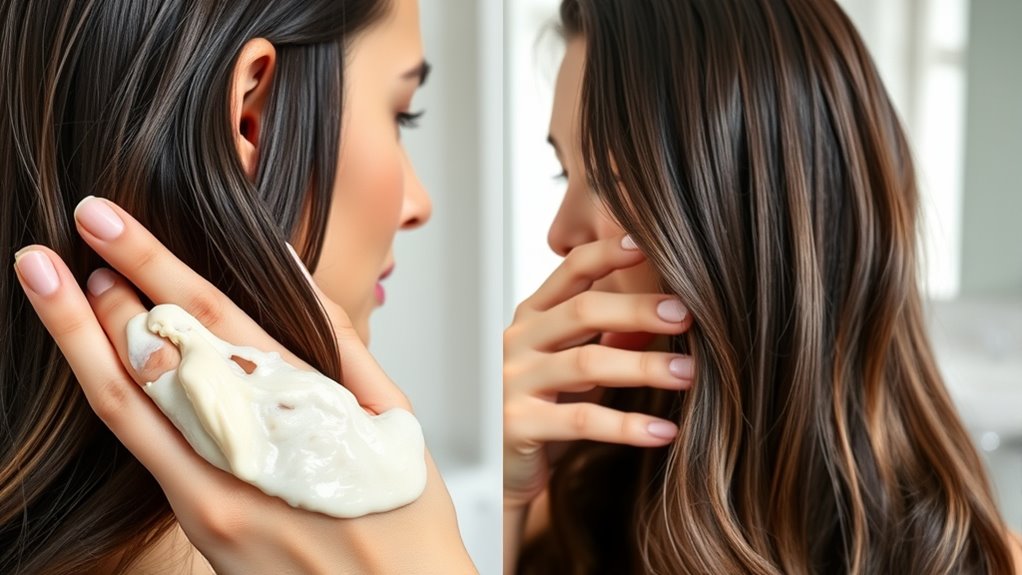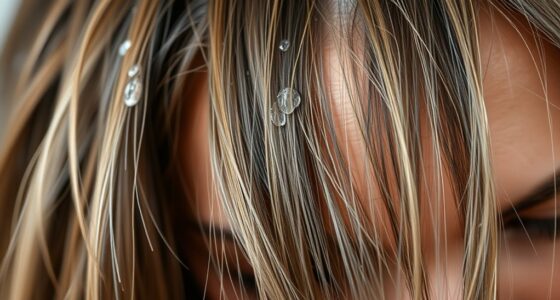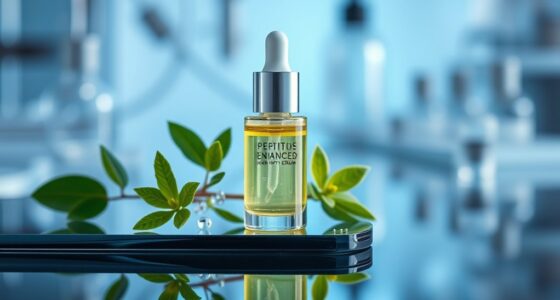To get the best results from deep conditioning and hair masks, start by evaluating your hair’s porosity—high or low—to choose the right product. Apply the mask from roots to ends, focusing on scalp hydration if needed. Leave it on for 15-30 minutes, using heat to boost absorption, then rinse with cool water to seal the cuticle. Consistent use enhances moisture and strength, and uncovering more tips helps you optimize your hair care routine.
Key Takeaways
- Assess your hair porosity to choose the right mask type—rich in emollients for high porosity, lightweight for low.
- Apply the mask evenly from roots to ends, focusing on scalp hydration with nourishing ingredients like aloe vera or tea tree oil.
- Use heat, such as a warm towel or shower cap, during treatment to enhance absorption and effectiveness.
- Leave the mask on for 15–30 minutes, then rinse thoroughly with cool water to seal the cuticle and lock in moisture.
- Incorporate regular deep conditioning into your routine to improve hair strength, shine, and overall health.

Deep conditioning and hair masks are essential treatments that can transform dull, damaged hair into healthy, vibrant strands. When you incorporate these treatments into your routine, you’re giving your hair a boost of moisture and nourishment that it desperately needs. Understanding how scalp hydration and hair porosity play roles in this process helps you choose the right mask and application method, ensuring you get the best results. If your scalp feels dry or itchy, or if your hair is overly porous, using targeted deep conditioning can make a noticeable difference. Proper hydration at the scalp encourages healthy follicle activity, resulting in stronger, shinier hair, while addressing hair porosity helps lock in moisture more effectively. Evaluating your hair’s porosity can help prevent over- or under-conditioning, optimizing your regimen.
First, assess your hair’s porosity. If your hair absorbs moisture quickly but also loses it just as fast, you likely have high porosity hair. This means your hair cuticles are often lifted or damaged, making it harder to retain moisture. In this case, opt for masks rich in emollients and proteins that help seal the cuticle, reducing moisture loss. Conversely, if your hair struggles to absorb products or feels stiff, you probably have low porosity hair. For this type, lightweight masks with heat can open the cuticles, allowing better penetration of nourishing ingredients. Knowing your porosity helps you tailor your deep conditioning routine to maximize hydration and restore balance.
Next, focus on scalp hydration. A well-hydrated scalp is the foundation for healthy hair growth. Before applying a mask, gently massage your scalp to stimulate circulation and loosen any buildup. Use a mask designed specifically for scalp health, containing ingredients like aloe vera, tea tree oil, or peppermint, which soothe and hydrate the skin. Applying the mask from roots to ends ensures that moisture reaches every strand, especially the areas that tend to be dry or brittle. Cover your hair with a shower cap or warm towel to create a heat trap, enhancing absorption. Leave the mask on for the recommended time—usually 15 to 30 minutes—and rinse thoroughly with cool water to help seal the cuticle. Incorporating proper hydration techniques can further improve the efficacy of your deep conditioning routine.
Frequently Asked Questions
Can Deep Conditioning Treatments Damage Fine or Thin Hair?
Deep conditioning treatments can cause hair breakage or product buildup if you use them too often or choose heavy formulas. For fine or thin hair, opt for lightweight masks and limit treatments to once a week. You should also rinse thoroughly to prevent buildup, which can weigh hair down and weaken strands. When used properly, deep conditioning benefits your hair without risking damage, making it healthier and stronger.
How Often Should I Apply a Hair Mask for Best Results?
You should apply a hair mask once a week for ideal hair health. This frequency allows the treatment to nourish and repair without overloading your strands. Think of it like watering a plant—too much can cause harm, but just enough encourages growth. Regular application helps maintain moisture, strength, and shine, especially if your hair is damaged or dry. Stick to this schedule for the best results without risking damage.
Are There Natural Ingredients That Work Better Than Store-Bought Masks?
You can definitely find natural ingredients that work better than store-bought masks. DIY remedies with ingredients like honey, coconut oil, and avocado are excellent for nourishing your hair. Herbal infusions such as chamomile or rosemary can boost shine and strength. These natural options often contain fewer chemicals, making them gentler and more effective. Experiment with these ingredients to create personalized hair treatments that suit your hair type and needs.
Should I Use Heat With Every Deep Conditioning Session?
You don’t need to use heat with every deep conditioning session. Applying heat can help with hair porosity, allowing the mask to penetrate better, but overdoing it might damage your hair. Use heat sparingly—perhaps once a week or when your hair feels extra dry. Always listen to your hair’s needs and avoid excessive heat, which can lead to dryness or breakage, especially if your hair is already fragile.
Can Deep Conditioning Help With Hair Loss or Scalp Issues?
Yes, deep conditioning can help with hair loss and scalp issues by promoting scalp hydration and strengthening your hair. When you regularly use masks, you improve scalp health, reduce dryness, and support hair growth. Focus on nourishing ingredients like biotin or keratin to strengthen fragile strands. Consistent deep conditioning creates a healthier scalp environment, which can minimize hair loss and boost overall hair vigor.
Conclusion
Think of deep conditioning and hair masks as your hair’s gentle shield, restoring strength like a comforting embrace after a long day. Each treatment is a small act of kindness, nurturing your hair’s crown and renewing its spirit. When you care for your hair this way, you’re not just nourishing strands—you’re shining with confidence and resilience. Let your hair be a symbol of self-love, radiating beauty from within, one nourishing moment at a time.
Claire has a knack for turning complex dermatological concepts into engaging, easy-to-understand articles. Her work primarily focuses on creating detailed reviews and thought-provoking articles in the “Vetted” category. Claire’s writing not only informs but also inspires our community to try new skincare solutions.










